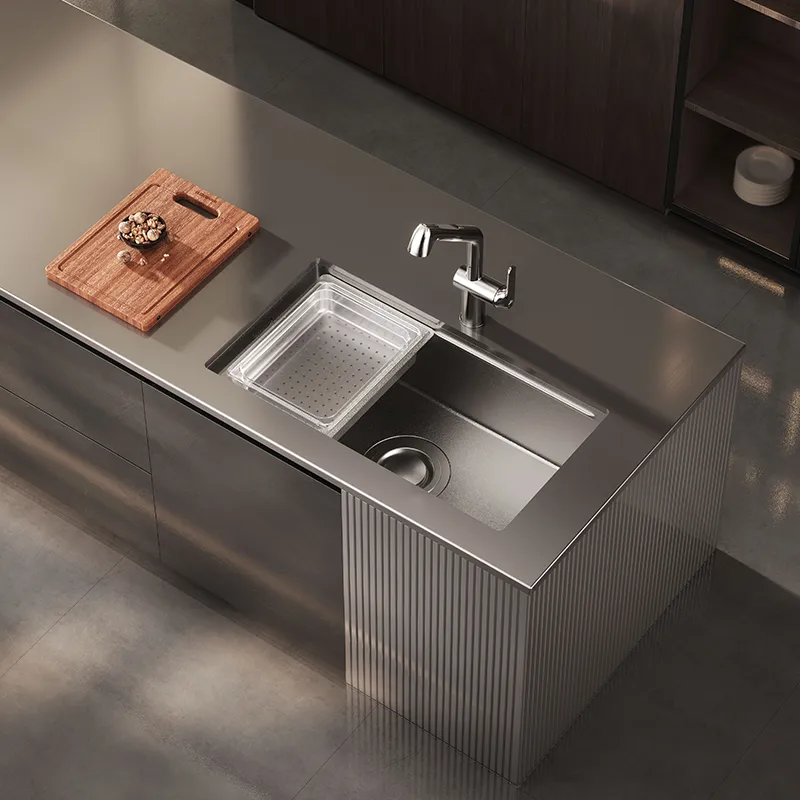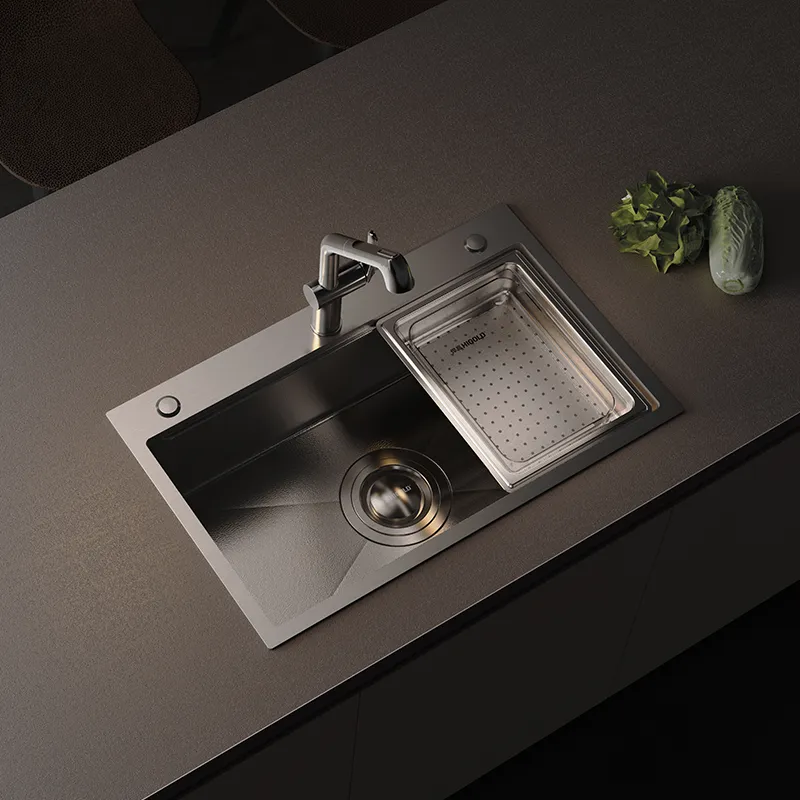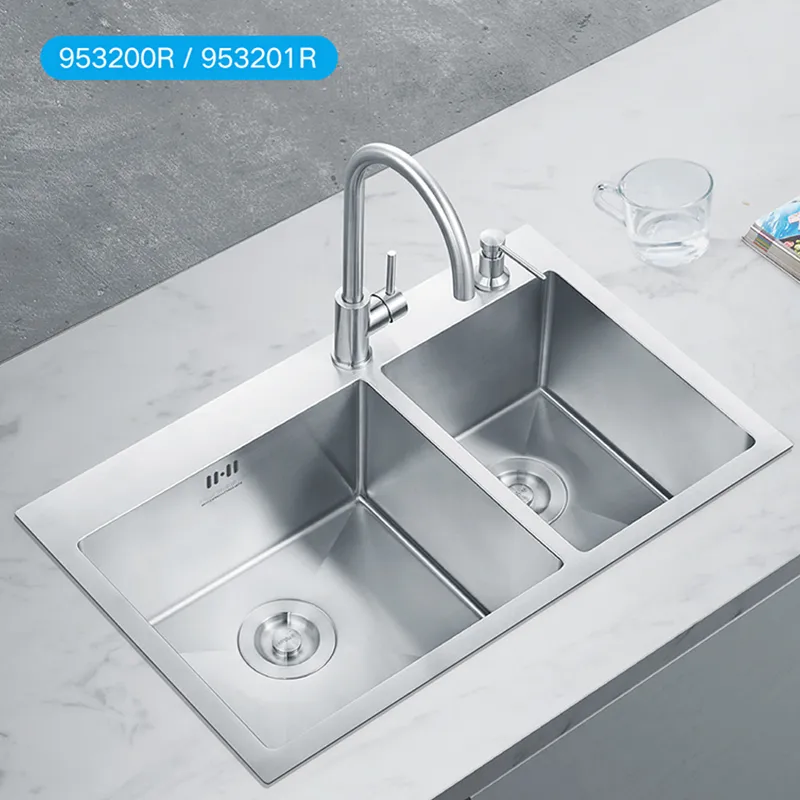In modern kitchen design, handmade stainless steel sinks, with their high-end feel, thick, practical materials, and fine craftsmanship, are becoming the preferred choice of more and more families and designers.
However, many people face a common question when purchasing:
"Is a handmade stainless steel sink more suitable for undercounter or overcounter installation?"
This seemingly simple question actually involves multiple factors, including structural characteristics, aesthetics, installation difficulty, daily cleaning, and durability.
This article will focus on this core question and conduct an in-depth analysis of the performance of stainless steel handmade sinks in different installation methods to help you choose the most suitable solution.

What is the difference between a stainless steel handmade sink and a regular sink?
Handmade stainless steel sinks are not stamped and formed in one go using large molds. Instead, craftsmen cut, bend, weld, and polish stainless steel sheets through multiple processes.
This process creates distinct angles and sharp lines, embodying the "perpendicular style" sought after in modern kitchens. Compared to conventional stamped sinks, handmade sinks offer the following key advantages:
• Thickness: Typically 1.2mm-1.5mm, making them less prone to deformation.
• Highly customizable: Flexible customization based on cabinet size, sink depth, and functional areas.
• More refined design: Delicate weld lines, sharp angles, and a strong sense of layering.
• More stable structure: Straight walls, strong pressure resistance, and a longer service life.
Precisely because of these advantages, the installation method of handmade stainless steel sinks has a significant impact on their aesthetics and practicality.

What is the difference between under-counter and over-counter installation?
In the kitchen, sinks are primarily installed in two ways: under-counter and over-counter.
The differences between these two methods extend beyond visual appeal, encompassing multiple aspects such as installation, use, and cleaning.
1. Definition of Under-Counter Installation
Under-counter installation involves recessing the sink beneath the cabinet countertop, creating a smooth transition between the countertop and sink edge. The sink frame is invisible from above, enhancing the overall look and creating a simple and elegant appearance.
Features:
• Hidden edges keep the countertop clean and tidy;
• Water residue can be pushed directly into the sink when cleaning the countertop;
• Requires a strong countertop material (such as quartz, engineered stone, marble, etc.).
2. Definition of Over-Counter Installation
Over-counter installation is the most traditional and common method. The sink is recessed into the countertop opening, with the edge protruding above the countertop.
Features:
• Easy installation and minimal requirements for the countertop;
• The edge prevents overflow;
• Water and dirt easily accumulate in the seams.
So, for handmade stainless steel sinks with a thicker structure and sharper edges, which installation method is most suitable? This is the question we will explore in depth in the following sections.

Are handmade stainless steel sinks suitable for under-counter installation?
1. Aesthetics: Under-counter installation better demonstrates the precision of craftsmanship
The lines and detailed finishes of handmade stainless steel sinks are their greatest strengths. With an undercounter installation, the countertop and sink become one, with the metal edge hidden underneath, creating a clean, sleek look.
This design is particularly well-suited for modern, minimalist, and light luxury kitchen styles, maximizing the quality of the stainless steel and the spatial depth.
2. From a Cleaning Perspective: Undercounter Installation is Easier
The biggest advantage of undercounter installation is that water accumulates in the edges.
During use, debris, vegetable leaves, and water droplets can be pushed directly into the sink without getting stuck on the edges, making cleaning more efficient.
This is extremely convenient for families who cook and clean frequently.
3. From an Installation Perspective: Countertop Load-Bearing Capacity is Key
Undercounter installation places high demands on the countertop material. Because stainless steel handmade sinks are heavy and have thick welded structures, the countertop must possess sufficient load-bearing capacity and sealing properties.
Commonly Suitable for:
• Quartz Countertops
• Natural Marble Countertops
• Solid Artificial Stone Countertops
However, undercounter installation is not recommended for wooden countertops or veneers, as moisture can cause the countertop to deform.
4. From a Sealing and Maintenance Perspective: Waterproofing is Important
Under-counter installations require waterproof silicone sealing around the edges to prevent water seepage.
The installation must be performed by a professional technician to ensure a tight fit between the sink and the countertop. Failure to do so may result in water seepage after long-term use.
Conclusion:
Under-counter installations can enhance the aesthetics and luxury of handmade sinks, but only with precise construction and appropriate countertop material.
Are handmade stainless steel sinks suitable for above-counter installation?
While under-counter installations are more modern, above-counter installations still offer irreplaceable practicality, especially in specialized environments.
1. Easy Installation and Wide Compatibility
Above-counter installations require lower requirements for countertop material, and can accommodate wood, veneer, and artificial stone countertops.
The installation process is simple; the sink can usually be placed directly into a pre-cut cabinet and sealed.
For users seeking convenient installation or the ability to remove and replace the sink later, an above-counter installation is more practical.
2. Spill-proof Rim
The rim of an above-counter sink is elevated above the countertop, effectively preventing water from spilling during cleaning. If kitchen users frequently wash large quantities of vegetables and dishes, a countertop frame can prevent water from overflowing and protect cabinets.
3. Strong Countertop Protection
When mounted above the countertop, the sink's weight is supported by the countertop, eliminating the need for adhesive support.
This effectively prevents edge deformation from stress on wood or composite countertops.
4. Visually Enhanced Dimensionality
Some kitchen designs intentionally utilize metal frames as decorative elements, highlighting an industrial or metallic feel.
In these cases, the sharp corners of a stainless steel handmade sink can become a visual focal point.
Conclusion:
Above-counter installation offers greater flexibility and ease of installation, and is also more suitable for countertops with weaker load-bearing capacity or unusual materials.

Undermount vs. Overmount Handmade Stainless Steel Sinks: Pros and Cons
Comparison Dimensions | Undercounter installation | Countertop installation |
| Aesthetics | Clean lines, strong integrity | Distinct border, traditional style |
| Ease of Cleaning | Seamless, easy to clean | Edges susceptible to water and oil accumulation |
| Installation Difficulty | High, requires professional installation | Easy to install, easy to install, easy for ordinary workers |
| Countertop Requirements | Strong load-bearing capacity, good waterproofing | Low requirements, wide compatibility |
| Spill Protection | Slightly weak, requires precision sealing | Protruding border provides waterproofing |
| Maintenance Difficulty | Difficult to replace | Easy to replace |
| Overall Cost | Slightly high | Low cost |
| Visual Style | Modern, minimalist, high-end | Practical, stable, and has a strong industrial feel |
This comparison demonstrates that both installation methods have their pros and cons, depending on the application scenario and personal needs.
Why are handmade stainless steel sinks more commonly designed for undercounter installation?
While both installation methods are feasible, undercounter installation is more common in high-end kitchen designs.
The main reasons are as follows:
• Highly compatible with craftsmanship: The right-angled design of a handmade sink allows for a seamless fit under the countertop.
• More premium visuals: With the edges hidden, the stainless steel appears purer, enhancing the overall quality of the kitchen.
• Compatible with modern cabinet design trends: Most kitchens today pursue clean lines, and undercounter installation better reflects this design philosophy.
This doesn't mean that overcounter installation is inappropriate; rather, it means that within the overall design, undercounter installation can better showcase the aesthetic advantages of a handmade sink.
What factors should be considered before installation?
Before choosing between overcounter and undercounter installation, consider the following factors:
1. Countertop material
Solid stone countertops → Undercounter installation is recommended;
Wood or veneer countertops → Overcounter installation is recommended.
2. Frequency of kitchen use
Frequent cooks and cleans → Undercounter installation is easier to keep clean;
Occasional or decorative use → Overcounter installation is simpler to maintain.
3. Aesthetics
If you're looking for a modern, minimalist style, choose an undercounter installation.
If you prefer an industrial, metallic finish, choose an above-counter installation for a more harmonious look.
4. Budget and Construction Conditions
Under-counter installation requires a high level of craftsmanship and labor costs;
Above-counter installation is economical and offers low maintenance.
Can a handmade stainless steel sink be used both above-counter and under-counter?
Some brands offer "universal frames" that support both installation methods. However, you should confirm in advance whether the opening dimensions and mounting structure are compatible.
Is an under-counter handmade stainless steel sink prone to falling off?
No. As long as it's securely installed and equipped with brackets, it won't fall off during normal use. Professional installation is key.
Is a above-counter handmade stainless steel sink prone to water seepage?
If the edges are not properly sealed, water can seep in. Therefore, ensure the silicone seal is evenly sealed during installation and inspect regularly.
Can an under-counter installation be replaced with an above-counter one?
Theoretically, it's possible, but it requires re-drilling and processing the countertop edges, which is a significant undertaking. A one-time selection method is recommended.
Can I mix different product models in one container order?
Yes, Higold allows buyers to combine multiple sink and faucet models in a single container. This flexibility helps distributors test new products while maintaining a balanced inventory. Mixing orders is also cost-effective, reducing logistics expenses per unit. Buyers can request specific container load plans and receive transparent price breakdowns.


